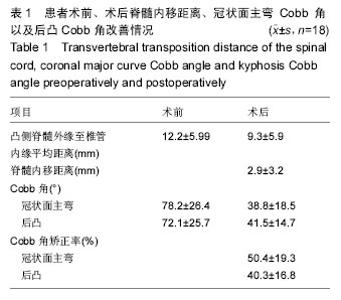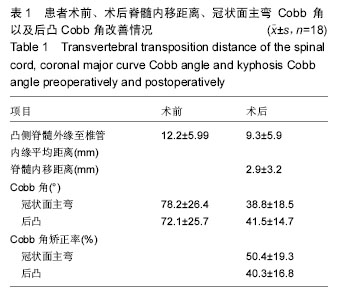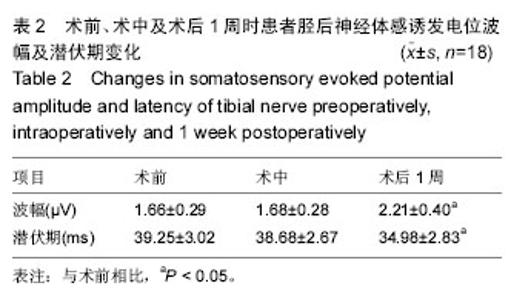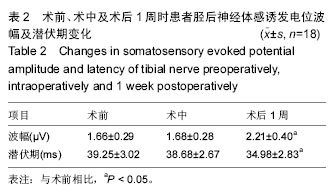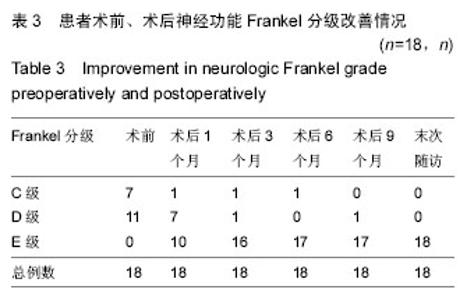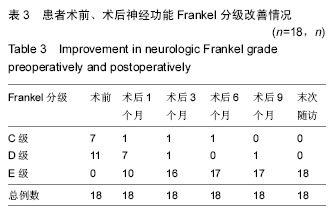| [1] 邹传奇,初同伟,周跃.一期经后路半椎体切除矫治先天性脊柱半椎体侧后凸畸形研究进展[J]. 中国修复重建外科杂志, 2014, 28(7): 909-912.
[2] 蔡明,刘雅,贾小平,等.后路全脊椎切除折顶矫形术治疗重度脊柱角状后凸研究[J].中国医药指南, 2013, 11(33): 335-336.
[3] 邱勇.退变性脊柱侧凸的分型与治疗[J].中国骨与关节杂志,2013, 2(10): 541-545.
[4] 潘林.手术治疗脊柱侧凸35例临床分析[J].当代医学, 2014, 20(32):84.
[5] 孙旭,钱邦平,邱勇,等.先天性胸腰段侧后凸畸形三柱截骨矫形术后冠状面失代偿[J].中华骨科杂志, 2014, 34(9): 903-908.
[6] Zeng Y, Chen ZQ, Qi Q, et al. The posterior surgical correction of congenital kyphosis and kyphoscoliosis: 23 cases with minimum 2 years follow-up. Eur Spine J. 2013; 22(2): 372-378.
[7] Sadowsky CL, Hammond ER, Strohl AB, et al. Lower extremity functional electrical stimulation cycling promotes physical and functional recovery in chronic spinal cord injury. J Spinal Cord Med. 2013;36(6): 623-631.
[8] Weiss HR, Goodall D. Rate of complications in scoliosis surgery- a systematic review of the Pub Med literature. Scoliosis. 2013;3(9):1-18.
[9] Park JH, Hyun SJ. Intraoperative neurophysiological monitoring in spinal surgery. World J Clin Cases. 2015;3(9): 765-773.
[10] 曾忠友,孙德弢,吴鹏,等.下腰椎骨折的损伤特点与改良胸腰椎损伤分类及损伤程度评分系统的应用[J]. 脊柱外科杂志, 2015,13(5): 294-298.
[11] 张宏其,楚戈,潘超,等.单一后路半椎体选择性部分切除内固定术治疗先天性脊柱侧后凸畸形[J]. 中国修复重建外科杂志, 2015, 29(3): 315-320.
[12] 卡哈尔•艾肯木,楚戈,黄佳,等.后路椎体环截及钛合金钉棒内固定治疗重度脊柱畸形[J].中国组织工程研究, 2013, 17(3): 7534-7539.
[13] 邱勇,刘臻,朱泽章,等.脊髓内移术在脊柱角状侧后凸畸形伴神经损害的后路矫形内固定中的作用[J]. 中华骨科杂志, 2015, 35(9):883-889.
[14] 黄霖,赵敏,王鹏,等.脊柱手术中多模式神经电生理监测异常的原因分析及处理对策[J].中国脊柱脊髓杂志, 2015, 25(7):594-601.
[15] 殷钰涵,杨俊锋,王建伟.诱发电位在脊髓损伤中的应用[J]. 中国中医骨伤科杂志, 2015, 23(1):69-71.
[16] 史图龙,尚咏.术中神经监测技术在脊柱手术中的临床应用[J].颈腰痛杂志, 2015, 36(2):150-153.
[17] 庄乾宇,王树杰,仉建国.经颅电刺激运动诱发电位监测标准化方案在1543例脊柱畸形矫形手术中的应用[J].中华骨与关节外科杂志,2015, 8(1): 27-31.
[18] 黄霖,赵敏,王鹏,等.脊柱手术中多模式神经电生理监测异常的原因分析及处理对策[J].中国脊柱脊髓杂志, 2015, 25(7): 594-601.
[19] 刘臻,邱勇,朱卫国,等.伴神经损害脊柱侧后凸畸形患者脊髓内移后路矫形术后神经电生理变化[J].中国脊柱脊髓杂志,2015,5(7): 580-584.
[20] 席志鹏,谢林,康然,等.体感诱发电位与运动诱发电位监测在颈椎手术中的应用价值[J].中国当代医药,2014, 21(29): 42-46.
|
